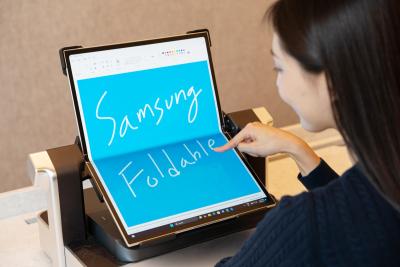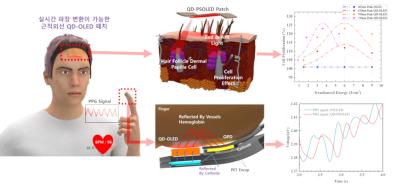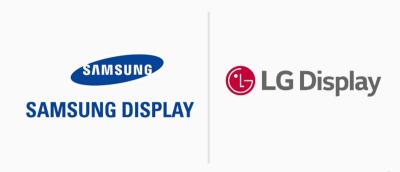QD-OLED displays
OLED displays are made from organic emitter materials - and are gaining in popularity as these next-generation displays offer excellent image quality and novel form factors.
Quantum Dots are tiny particles that have excellent photonic emission properties - and are used widely today in many LCD displays as the QD photoluminescence features enable the conversion of blue LED light to red and green light to create full-color displays that are better than white-backlit LCDs. QD particles can also be used to create emissive displays, in which the QDs themselves emit the light - read more about QD displays here.
QD-OLED displays are hybrid displays that use a combination of OLED emitters with QD color conversion layers and/or QD emitters. The basic idea is that the display uses only blue OLED emitters, and the QD layers conversts some of the pixels to red and green, thus creating a full color display.
Samsung QD-OLED
Samsung is the only company that have commercialized QD-OLED displays (at least until now). Samsung's QD Displays use blue OLED emitters and quantum-dots that convert the blue light to red and green light. In 2019 Samsung Display announced its decision to invest $10.85 billion in QD-OLED TV R&D and production lines. A few years later, SDC started to produce panels in its first fab, mass producing TV and monitor QD-OLEDs.
Samsung attracted several customers (Sony and Samsung Electronics for TV panels, and several companies for its monitors), and these displays have been very well received by the market. Samsung is currently producing around a million QD-OLED panels per year. The future roadmap of Samsung's QD-OLED displays is not clear.

TCL H-QLED
In 2019 it was unveiled that China-based display maker TCL is developing a new hybrid display technology that uses a blue OLED emitter coupled with red and green QD emitters. All three emitter materials will be combined and printed using ink-jet printing technology.
TCL callקג this technology H-QLED and said that this could prove to be the technology of choice for TCL's future high-end emissive TV displays. For more information on TCL's H-QLED, click here. The company, however, did not update on its H-QLED technology since 2019.

Samsung Electronics announced its 2025 OLED TV range
Samsung Electronics announced its 2025 OLED TV range, with three different series. The TVs use a combination of SDC's QD-OLED panels (latest generation that reaches 4,000 nits) and LGD's OLEDs.
The top of the range is the S95F, Samsung's flagship 2025 TV, that will be available in 55", 65", 77" and 83" sizes. The S95F offers 4K 165hzQD-OLED panels (except the 83-inch model which uses LG's WOLEDs, apparently). The S95F TVs use Samsung's new NQ4 AI Gen3 video processor.
Samsung Display shows new OLED technologies at CES 2025
Samsung Display is set to show new OLED technologies at CES 2025, including new foldable display, rollable ones, automotive displays, next-gen QD-OLED panels and more.
So first up, Samsung will be showing a 18.1 foldable OLED display (which it says is the world's largest). This panel is suitable for IT devices - to enable devices that combine tablet, laptop and monitor devices into one. When folded, this display is 13.1" in size.
UBI Research: the OLED emitter market reaches a new high in Q3 2024
UBI Research estimates that the volume of OLED emitting materials purchased in Q3 2024 reached 32.7 tons, which is the highest ever, with the previous record in 2021. UBI expects 2024 as a whole to be the record year in OLED emitter material shipments.
In terms of customers, SDC holds the largest share with 41.4% of the total market, followed by LGD (20.5%), BOE (11.6%) and Visionox (8.3%). In terms of architecture, 83.7% of all emitter materials went into RGB OLEDs, 11.3% into WOLED (LG's WRGB) panels and 2.8% into QD-OLED panels.
Applied Materials launches a maskless OLED production technology, to support 8-Gen high efficiency OLED deposition and encapsulation
Applied Materials announced a technology, branded as MAX OLED that enables OLED display production on large glass substrates, aiming to provide a cost-effective solution to produce TV and TV displays. Applied developed and patented a new OLED pixel architecture and a "dramatically different manufacturing approach" that the company says enables brighter, clearer, more energy-efficient and longer-lasting.
Applied's new MAX OLED systems can scale from 6-Gen substrates to 8-Gen substrates, supporting the new wave of IT OLED production lines. Applied says that its new solution has strong customer interest - and already achieved repeat orders from several leading display makers (see below). Specifically, Applied announced that it will supply an R&D system to Samsung Display that will test the new production technology for its AMOLED and QD-OLED production technologies.
Samsung may launch 83-inch QD-OLED TVs in 2025
According to reports, based on information found on a parts database, Samsung Electronics is getting ready to launch a 83-inch QD-OLED TV in 2025. The 83-inch panel will be introduced in the 2025 QD83S9F TV, and Samsung us likely to use both WOLED and QD-OLED panels in this TVs as was done in the 2024 S90D.
This is interesting news. Samsung's QD-OLED technology is under pressure and it is not clear whether Samsung intends to continue investing in it, and expanding production capacity. It seemed as if SDC is mostly focused on gaming monitors, but perhaps now it is also expanding its TV panel range, which is a welcome change.
Researchers use a high-output flexible QD-OLED patch to encourage hair growth
Researchers at Korea's Gachon University, in collaboration with InnoQD and researchers from Chungbuk National University, have developed a new QD-OLED patch that can encourage hair growth. The patch can also measure heart rate at the same time.
The researchers used a flexible OLED device, and covered it with quantum dots that emit near-infrared (NIR) light. The OLED device is a tandem blue OLED device, that offers a high light output. The researchers say that when attached to the head, the patch encourages hair collicle cell growth, with a measured improvement of 23% in hair growth.
Samsung Display developed new technology to recycle QD materials for its QD-OLED production process
Samsung Display announced that it has developed a new technology that can recover around 80% of the quantum dots ink used in its QD-OLED production process. The recovered inks is refined through advanced synthesis technology that revives its purity and optical properties. The company will apply this technology, to its process and it is expected to save around 10 billion Won (around $7.3 million USD) each year in QD materials cost.
It turns out that even though the QD layers are inkjet printed, there is still significant waste of materials, as around 20% of the total QD ink used in the process remains in the nozzles and cannot be used. This new technology will enable SDC to make its QD-OLED panels more competitive with other large-area panel technologies.
Does it make sense for LG Display and Samsung Display to merge?
In this article, we examine the theoretical question of whether or not it makes sense for LG Display and Samsung Display to merge, into one company.
Note that we have no indications that such a merger is even considered by the two companies, but we feel this is a fascinating topic that should be explored, and is supported by several strong arguments.
We'll start with a short introduction to the two companies, then see why there are many reasons to pursue a merger, then explain the reasons against a possible merger, and finally detail the current financial situations of both companies.
Samsung Display and LG Display
Samsung Display Corporation (SDC) is a subsidiary of Samsung Electronics. SDC is a leader in OLED production, with a market share of over 40% in the small OLED display market (the second largest player, BOE, holds a market share of around 15%). SDC produces over 300 million AMOLED displays per year - supplying them to Apple's iPhones and tablets, Samsung Electronics Galaxy phones, and many more. The Company also produces larger-area QD-OLED panels for TVs and gaming monitors, and has a capacity of producing around a million TV panels per year. SDC no longer produces any LCDs. SDC does produce microLED displays (but on a very small scale, this is currently a strictly next-gen display technology), and the company develops OLED microdisplays (and also holds OLED microdisplay producer eMagin which it acquired in 2023 for $243 million).
Sony's QD-OLED A95L TV wins Value Electronics' 2024 TV Shootout
US retailer Value Electronics hosted their annual TV shootout® (now in its 20ths year), checking high-end calibrated TVs to see which model provides the best image quality. This year, Value Electronics tested six TVs, three of which were OLEDs, and three miniLEDs.
The three OLED TVs were the LG G4, Samsung S95D and Sony A95L. As in previous years, the top performing TV is a QD-OLED TV - specifically Sony's A95L. All of the three OLED TV models outperformed the miniLED TVs, as you can see by clicking on the image above.
Samsung sold over 20,000 of its new QD-OLED gaming monitors in a month
Samsung Electronics says that a it has sold over 20,000 units of its new QD-OLED monitors, the Odyssey G8 and G6 in a month. The company says that the new monitors are popular in Europe, North America - and Southeast Asia.
A couple of months ago IDC says Samsung is leading the OLED monitor market, with a 34.7% market share by revenue (and 28.3% market share by shipments. Samsung Electronics started selling OLED monitors in 2023.
Pagination
- Page 1
- Next page











